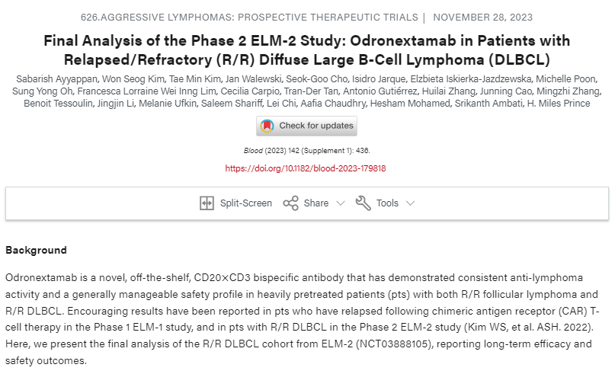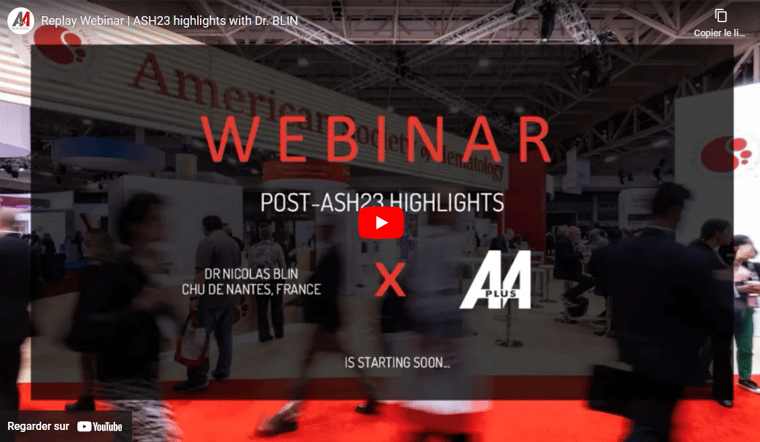Discover the transcription of our Post-ASH 23 webinar with Dr. BLIN, provides comprehensive coverage of several pivotal studies related to Acute Myeloid Leukemia (AML) from the ASH23 congress. Dr. BLIN delves into the specifics of each study, discussing their design, patient characteristics, main findings, and implications for the treatment of AML. Below is a condensed transcript covering the essence of each study discussed in the video!
Click to discover the DLBCL replay video!
Diffuse Large B-cell Lymphoma

In this video, Dr. BLIN reviews critical findings from the ASH23 congress regarding the treatment of Diffuse Large B-Cell Lymphoma (DLBCL), particularly focusing on innovative therapeutic approaches for relapsed or refractory cases. He discusses an abstract detailing the final analysis of a trial involving a next-generation anti-CD3 and anti-CD20 monoclonal antibody in patients who have undergone at least two prior lines of systemic treatment.
1. ELM-2: Final analysis of odronextamab in relapsed/refractory DLBCL

Overview
- Patient Population: The study involved 127 patients with relapsed or refractory DLBCL who have previously received chemotherapy and anti-CD20 agents.
- Treatment: Patients were treated with a novel anti-CD3 and anti-CD20 monoclonal antibody, aiming to evaluate its efficacy.
- Endpoints: The primary endpoint was the overall response rate (ORR), with secondary endpoints including complete response (CR) rate, duration of response, and survival data.
Key Findings
- Efficacy: The ORR was 52%, with a CR rate of 31%, indicating a similar overall response to existing therapies like epcoritamab but with a potential improvement in CR rates. The median duration of response was 10 months, with 48% of patients maintaining response at 12 months and 36% at 24 months.
- Subgroup Benefits: Analysis showed that all subgroups, including those with de novo DLBCL and those transformed from low-grade non-Hodgkin lymphoma, benefited from the treatment. Notably, patients who were double refractory to two prior lines of therapy had an ORR of 40%.
- Safety Profile: The treatment was well-tolerated, with a safety profile consistent with known data for similar therapies. Cytokine release syndrome (CRS) was observed in 53% of patients, predominantly grade 1 and 2, with no reported neurologic toxicity (ICANS).
This abstract presents promising data for a next-generation anti-CD3 and anti-CD20 monoclonal antibody in treating relapsed or refractory DLBCL, showcasing comparable ORR to current therapies with a slight improvement in CR rates. The manageable safety profile and significant duration of response underline the potential of this therapy as a valuable addition to the DLBCL treatment arsenal, particularly for patients with limited options due to previous treatment failures.
Dr. BLIN's analysis emphasizes the ongoing efforts to enhance therapeutic strategies for DLBCL, focusing on targeted monoclonal antibodies as a means to improve patient outcomes in challenging relapsed or refractory cases. The discussed trial's results contribute to the evolving landscape of DLBCL treatment, offering hope for more effective and tolerable options for patients in need.
If you missed our previous sessions on Multiple Myeloma, Acute Myeloid Leukemia, and Myelodysplastic Syndrome, you can now read our blog posts by clicking the buttons below:




